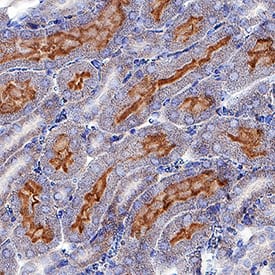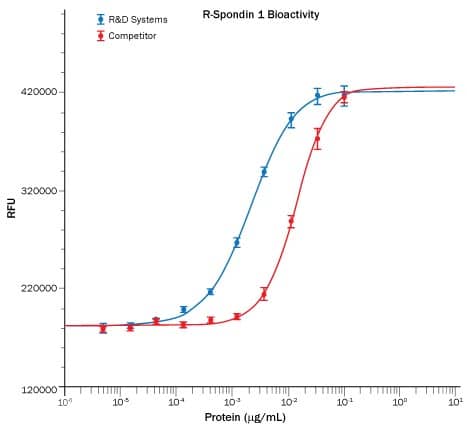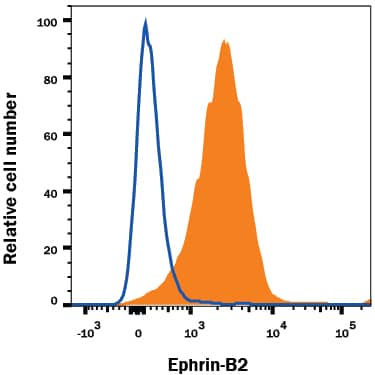Human FLRT3 Antibody Summary
Lys29-Pro528
Accession # Q9NZU0
Customers also Viewed
Applications
Please Note: Optimal dilutions should be determined by each laboratory for each application. General Protocols are available in the Technical Information section on our website.
Preparation and Storage
- 12 months from date of receipt, -20 to -70 °C as supplied.
- 1 month, 2 to 8 °C under sterile conditions after reconstitution.
- 6 months, -20 to -70 °C under sterile conditions after reconstitution.
Background: FLRT3
FLRT3 is one of three FLRT (fibronectin, leucine rich repeat, transmembrane) glycoproteins expressed in distinct areas of the developing brain and other tissues (1, 2). The 85-95 kDa type I transmembrane (TM) human FLRT3 is synthesized as a 649 amino acid (aa) precursor with a 28 aa signal sequence, a 500 aa extracellular domain (ECD), a 21 aa TM segment and a 100 aa cytoplasmic region. The ECD contains 10 N-terminal leucine-rich repeats flanked by cysteine-rich areas, and a juxtamembrane fibronectin type III domain (1). The human FLRT3 ECD shares 96%, 96%, 97%, 97%, 98%, and 81% aa sequence identity with mouse, rat, canine, bovine, equine, and Xenopus FLRT3 ECD, respectively, and 61% and 48% aa identity to human FLRT2 and FLRT3 ECDs, respectively. The fibronectin domain is responsible for binding to FGF receptors, and is thought to regulate FGF signaling during development (2, 3). The LRR domains are responsible for both the localization in areas of cell contact and homotypic cell-cell association (4). This may be through direct interaction with other FLRT molecules, or alternatively, by regulating internalization of adhesion molecules such as cadherins (4, 5). Developmentally, FLRT3 is located in somitic regions on dermatomyotomal muscle precursors and myotomal cells before their migration to the myotome and syndetome, respectively (2). FLRT3 is also expressed at the midbrain/hindbrain boundary and in the apical ectodermal ridge where it may influence FGF signaling (2). Genetic deletion in mouse embryos results in defective headfold fusion and endoderm migration (6). Postnatally, FLRT3 mRNA is widely expressed (1). It is upregulated and promotes neurite outgrowth following experimental peripheral nerve injury in rats (7, 8).
- Lacy, S.E. et al. (1999) Genomics 62:417.
- Haines, B.P. et al. (2006) Dev. Biol. 297:14.
- Bottcher, R.T. et al. (2004) Nat. Cell Biol. 6:38.
- Karaulanov, E.E. et al. (2006) EMBO Rep. 7:283.
- Ogata, S. et al. (2007) Genes Dev. 21:1817.
- Maretto, S. et al. (2008) Dev. Biol. 318:184.
- Tsuji, L. et al. (2004) Biochem. Biophys. Res. Commun. 313:1086.
- Robinson, M. et al. (2004) Mol. Cell. Neurosci. 27:202.
Product Datasheets
Citations for Human FLRT3 Antibody
R&D Systems personnel manually curate a database that contains references using R&D Systems products. The data collected includes not only links to publications in PubMed, but also provides information about sample types, species, and experimental conditions.
7
Citations: Showing 1 - 7
Filter your results:
Filter by:
-
Non-apical mitoses contribute to cell delamination during mouse gastrulation
Authors: Despin-Guitard, E;Rosa, VS;Plunder, S;Mathiah, N;Van Schoor, K;Nehme, E;Merino-Aceituno, S;Egea, J;Shahbazi, MN;Theveneau, E;Migeotte, I;
Nature communications
Species: Mouse
Sample Types: Whole Tissue
Applications: Immunohistochemistry -
Brain exposure to SARS-CoV-2 virions perturbs synaptic homeostasis
Authors: Partiot, E;Hirschler, A;Colomb, S;Lutz, W;Claeys, T;Delalande, F;Deffieu, MS;Bare, Y;Roels, JRE;Gorda, B;Bons, J;Callon, D;Andreoletti, L;Labrousse, M;Jacobs, FMJ;Rigau, V;Charlot, B;Martens, L;Carapito, C;Ganesh, G;Gaudin, R;
Nature microbiology
Species: Human
Sample Types: Whole Cells
Applications: Immunocytochemistry -
Apicosome: Newly identified cell-type-specific organelle in mouse cochlear and vestibular hair cells
Authors: Xiaofen Li, Qirui Zhao, Xiaojie Yu, Wenhan Cao, Yingyi Zhang, Wanying Feng et al.
iScience
-
Multiregional profiling of the brain transmembrane proteome uncovers novel regulators of depression
Authors: Shanshan Li, Huoqing Luo, Ronghui Lou, Cuiping Tian, Chen Miao, Lisha Xia et al.
Science Advances
-
Increased expression of fibronectin leucine-rich transmembrane protein 3 in the dorsal root ganglion induces neuropathic pain in rats
Authors: M Yamada, Y Fujita, Y Hayano, H Hayakawa, K Baba, H Mochizuki, T Yamashita
J. Neurosci., 2019-07-25;0(0):.
Species: Rat
Sample Types: In Vivo, Tissue Homogenates, Whole Tissue
Applications: IHC, In Vivo, Western Blot -
Genetic ablation of FLRT3 reveals a novel morphogenetic function for the anterior visceral endoderm in suppressing mesoderm differentiation.
Authors: Egea J, Erlacher C, Montanez E, Burtscher I, Yamagishi S, Hess M, Hampel F, Sanchez R, Rodriguez-Manzaneque MT, Bosl MR, Fassler R, Lickert H, Klein R
Genes Dev., 2008-12-01;22(23):3349-62.
Species: Mouse
Sample Types: Whole Tissue
Applications: IHC -
Structural Basis of Teneurin-Latrophilin Interaction in Repulsive Guidance of Migrating Neurons
Authors: Del Toro D, Carrasquero-Ordaz MA, Chu A et al.
Cell
FAQs
No product specific FAQs exist for this product, however you may
View all Antibody FAQsIsotype Controls
Reconstitution Buffers
Secondary Antibodies
Reviews for Human FLRT3 Antibody
There are currently no reviews for this product. Be the first to review Human FLRT3 Antibody and earn rewards!
Have you used Human FLRT3 Antibody?
Submit a review and receive an Amazon gift card.
$25/€18/£15/$25CAN/¥75 Yuan/¥2500 Yen for a review with an image
$10/€7/£6/$10 CAD/¥70 Yuan/¥1110 Yen for a review without an image













